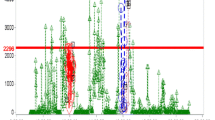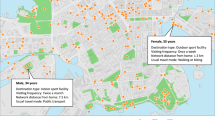Abstract
A number of studies in recent years have identified both self-report and objectively measured accessibility of recreational facilities as important predictors of physical activity in youth. Yet, few studies have: (1) examined the relationship between the number and proximity of objectively measured neighborhood physical activity facilities and respondents’ perceptions and (2) compared objective and self-report measures as predictors of physical activity. This study uses data on 1,367 6th-grade girls who participated in the Trial of Activity for Adolescent Girls (TAAG) to explore these issues. Girls reported whether nine different types of recreational facilities were easily accessible. These facilities included basketball courts, golf courses, martial arts studios, playing fields, tracks, skating rinks, swimming pools, tennis courts, and dance/gymnastic clubs. Next, geographic information systems (GIS) were used to identify all the parks, schools, and commercial sites for physical activity located within a mile of each girl’s home. These sites were then visited to inventory the types of facilities available. Girls wore accelerometers to measure their weekly minutes of non-school metabolic equivalent weighted moderate-to-vigorous physical activity (MW-MVPA). The number of facilities within a half-mile of girls’ homes strongly predicted the perception of easy access to seven out of nine facility types. Both individual facility perceptions and the total number of facilities perceived were associated with increased physical activity. For each additional facility perceived, girls clocked 3% more metabolic equivalent weighted moderate-to-vigorous physical activity (p < 0.001). Although girls tended to record 3% more of this kind of physical activity (p < 0.05) per basketball court within a mile of their homes, objective facility measures were otherwise unrelated to physical activity. The results from this study suggest that raising the profile of existing facilities may help increase physical activity among adolescent girls.

Similar content being viewed by others
References
Evenson K, Birnbaum A, Bedimo-Rung A, et al. Girls’ perception of physical environmental factors and transportation access: reliability and association with physical activity and active transport to school. Intl J Behavioral Nutr Physical Activity. 2006;3(28). Available from: www.ijbnpa.org/content/3/1/28.
Timperio A, Crawford D, Telford A, Salmon J. Perceptions about the local neighborhood and walking and cycling among children. Prev Med. 2004;38(1):39–47.
Dunton GF, Jamner MS, Cooper DM. Assessing the perceived environment among minimally active adolescent girls: validity and relations to physical activity outcomes. Am J Health Promot. 2003;18(1):70–73.
Cohen DA, Ashwood JS, Scott MM, et al. Public parks and physical activity among adolescent girls. Pediatrics. 2006;118(5):e1381–e1389.
Norman GJ, Nutter SK, Ryan S, Sallis JF, Calfas KJ, Patrick K. Community design and access to recreational facilities as correlates of adolescent physical activity and body-mass index. J Phys Act Health. 2006;3(Suppl 1):s118–s128.
Gordon-Larsen P, Nelson MC, Page P, Popkin BM. Inequality in the built environment underlies key health disparities in physical activity and obesity. Pediatrics. 2006;117(2):417–424.
Kirtland KA, Porter DE, Addy CL, et al. Environmental measures of physical activity supports: perception versus reality. Am J Prev Med. 2003;24(4):323–331.
Boehmer TK, Hoehner CM, Wyrwich KW, Brennan Ramirez LK, Brownson RC. Correspondence between perceived and observed measures of neighborhood environmental supports for physical activity. J Phys Act Health. 2006;3:22–36.
Michael Y, Beard T, Choi D, Farquhar S, Carlson N. Measuring the influence of built neighborhood environments on walking in older adults. J Aging Phys Act. 2006;14:302–312.
Jilcott SB, Evenson KR, Laraia BA, Ammerman AS. Association between physical activity and proximity to physical activity resources among low-income, midlife women. Prev Chronic Dis [serial online] 2007 Jan [date cited]. Available from: http://www.cdc.gov/pcd/issues/2007/jan/06_0049.htm.
Guest AM, Lee BA. How urbanites define their neighborhoods. Popul Environ. 1984;71(1):32–56.
Sastry N, Pebley AR, Zonta M. Neighborhood Definitions and the Spatial Dimension of Daily Life in Los Angeles. DRU-2400/8-LAFANS, April 2002.
Haney WG, Knowles ES. Perception of neighborhoods by city and suburban residents. Hum Ecol. 1978;6:201–214.
St. John C. Racial differences in neighborhood evaluation standards. Urban Aff Q. 1987;22:377–398.
Mesch GS, Manor O. Social ties, environmental perception, and local attachment. Environ Behav. 1998;30:504–520.
Stevens J, Murray DM, Catellier DJ, et al. Design of the trial of activity in adolescent girls (TAAG). Control Clin Trials. 2005;26:223–233.
Puyau MR, Adolph AL, Vohra FA, Butte NF. Validation and calibration of physical activity monitors in children. Obes Res. 2002;10(3):150–157.
Treuth MS, Almeida J, Catellier DJ, et al. Defining accelerometer thresholds for activity intensities in adolescent girls. Med Sci Sports Exerc. 2004;36(7):1259–1266.
Catellier D, Hannan P, Murray D, et al. Imputation of missing data when measuring physical activity by accelerometry. Med Sci Sports Exerc. 2005;37:S555–S562.
Schmitz KH, Treuth M, Hannan PJ, et al. Predicting energy expenditure from accelerometry counts in adolescent girls. Med Sci Sports. 2005;37(1):155–161.
Cohen DA, Ashwood S, Scott M, et al. Proximity to school and physical activity among middle school girls: the trial of activity for adolescent girls study. J Phys Act Health. 2006;3(Suppl 1):S129–S138.
Saunders RP, Moody J. Community agency survey: formative research results from the TAAG study. Health Educ Behav. 2006;33(1):12–24.
Mota J, Almeida M, Santos P, Ribeiro J. Perceived neighborhood environments and physical activity in adolescents. Prev Med. 2005;41:834–836.
Evenson KR, Scott MM, Cohen DA, Vorhees CC. Association of Girls’ Perception of Neighborhood Factors on Physical Activity, Sedentary Behavior, and Body Mass Index: The Trial of Activity for Adolescent Girls Study. Obesity. 2007;15(2):430–445.
Nationwide Personal Transportation Survey. 1997. Our nation’s travel: 1995 NPTS early results report. U.S. Department of Transportation: Federal Highway Administration. Available from: http://www.cta.ornl.gov/npts/1995/Doc/EarlyResults.shtml.
Golledge RG, Stimson RJ. Spatial Behavior: A Geographic Perspective. New York: Guilford Press; 1997.
Lloyd R. Spatial Cognition: Geographic Environments. Norwell MA: Kluwer Academic Publishers; 1997.
Snidjers TAB, Bosker RJ. Modeled variance in two-level models. Sociol Methods Res. 1994;22(3):342–363.
Acknowledgement
This work was funded by NIH/NHLBI Grant #R01HL71244 and Centers for Disease Control and Prevention U48/DP000056. The TAAG Study was also funded by grants from the NIH/NHLBI (#U01HL-66845, HL-66852, HL-66853, HL-66855, HL-66856, HL-66857, and HL-66858). We would like to thank the girls who participated in the study; the project coordinators for participant recruitment; and the members of TAAG Steering Committee, including: Russell Pate, Ph.D., University of South Carolina; Deborah Rohm-Young, Ph.D., University of Maryland College Park; Leslie Lytle, Ph.D., University of Minnesota; Timothy Lohman, Ph.D., University of Arizona; Larry Webber, Ph.D., Tulane University; John Elder, Ph.D., San Diego State University; June Stevens, Ph.D., The University of North Carolina at Chapel Hill; and Charlotte Pratt, Ph.D., National Heart, Lung, and Blood Institute. The TAAG Steering Committee was responsible for the design, conduct, and the management of the larger TAAG study and the review and approval of this manuscript. NHLBI also reviewed and approved this paper.
Special thanks to Lisa Staten for her helpful comments on the manuscript and to Scott Ashwood and Adrian Overton for their GIS expertise and work creating the database of objective built environment measures.
Author information
Authors and Affiliations
Corresponding author
Additional information
Scott is with the RAND Corporation, Arlington, VA 22202, USA; Cohen is with the RAND Corporation, Santa Monica, CA 90401, USA; Evenson and Cox are with the UNC Chapel Hill, School of Public Health, Chapel Hill, NC, USA.
Rights and permissions
About this article
Cite this article
Scott, M.M., Evenson, K.R., Cohen, D.A. et al. Comparing Perceived and Objectively Measured Access to Recreational Facilities as Predictors of Physical Activity in Adolescent Girls. J Urban Health 84, 346–359 (2007). https://doi.org/10.1007/s11524-007-9179-1
Published:
Issue Date:
DOI: https://doi.org/10.1007/s11524-007-9179-1




